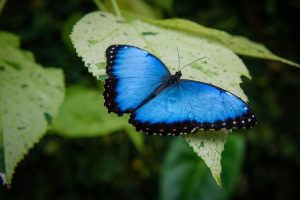Butterflies are one of the most beautiful insects that we know. Their movement is graceful. They have pretty wings and beneficial for our garden and flowers. It is not a surprise that butterflies are the most familiar of insects to human. For decades, butterflies have been interpreted in many ways from personification of the soul to omen for wealth, love and happiness. There are about 17.500 species of them across the globe! Some of us love to watch them as a hobby. The others love to collect the dead butterflies because of their colors. Who doesn’t love butterflies?
Butterflies are close to moths, from which they evolved. Both moths and butterflies have four wings covered with scales. They are not flying, but their wings are usually folded over its back.
Butterflies’ wings are spotted on. Not only covered in a bright color, but they are also patterned. They are made of two protein membranes, covered in tiny scales and hairs. The shapes, patterns, and colors in their wings are used to protect them from their predators by providing strong warning signals and confusing their eyes.
For example, the male blue morpho butterfly, one of the largest butterflies in the world with a wingspan up to 20 cm, has a magnificent metallic blue upper wings and brownish colors in the underside wings. So when the morpho butterfly lands and closes its wings, it only shows the predators the brown color as camouflage which is they think not the prey they looked before. The blue morpho butterfly can be found in the rain forest of Brazil and Guyana, South America.
Now, where do all the colors come from? Here’s a simple explanation answer. Let’s begin, shall we?
Despite Of Being Beautiful, What Makes Butterflies Have Variable Colors?

The changing colors: iridescence
Wings colors in butterflies come in two types, which are pigment.ordinary and structural, or sometimes the combination from these two. In our daily life, we know pigment colors are in the paints, inks, and also the green in plants, which means it is coming from some specific substances of chemical composition. Most butterflies have a different shade of brown or yellow from melanin, which is the same pigment in our tan skin or freckles!
On the other hand, structural colors come from physical manners, like a rainbow! Structural color explains why some of the butterflies’ colors seem to keep on changing or shifting when we are moving. This cool changing colors called iridescence. For short, it happens when light passes through a transparent multilayered surface, then the lights are reflected for more than once, create a multiple reactions compound and intensify colors. In butterflies, they have many more layers for light to pass through, giving the light more chances to reflect and magnify one another. Iridescence also happen in fish, peacock feathers, pearl seashells, and soap bubbles!
Multiple layers create multiple reflections
Remember that scales in butterflies’ wings that we have talked before? So this microscopic scales overlap like our roof tiles and appearing like dust to our eyes. These scales are divided into two to three layers. In Greek, it is named Lepidoptera, which means scaled-wings. Each of these scales has multiple layers separated by air. When the light come through to these layers, it is reflected for more than once and then combined, which is where some butterflies get their intense color when you see their wings.
Light is a wave. If the crests and the troughs of the waves are aligned, or in phase, they will cause constructive interference. Interference happens when light hitting the butterfly wing interacts with light reflected off it. As a result, the multiple slit interferences produce the iridescence. So the more layers that the butterfly has, the more the lights have a chance to interact with the reflected one to produce iridescence.
Let the lights guide them home
Some of them also show into the UV or ultraviolet spectrum. We cannot see UV spectrum with our eyes, but this one is important for butterflies, or monarch butterflies in specific, to guide them in the migration from North America to Mexico.
Combination of pigment and structural color
How about the combination of both structural and pigment color? This is where it’s getting more interesting. The effects from this are for example whenever you see a butterfly with yellow pigment underneath a structure color of blue iridescence, you might see the green shade as the result of these merging colors. It will start to move from yellow, blue, to green as you change your perspective or as the butterfly moves its wing. The reason behind these beautiful effects is that the lights enter different angels, which then give different outcomes.
LED on their wings
Do you know that butterflies have million of LEDs on their wings? Light Emitting Diode or LED is a colored light that mostly related to electronic equipment from our handphone, computes, tv sets, and more.
The most common colors of LEDs are red, yellow, and green. But nature doesn’t want to work easy so step up the game by designing butterflies with a variable of vibrant colors!
The other body structure also helps!
You can try by rubbing your finger (gently! do not harm the butterfly!), you will see the scales stick to your finger in the form of dust particles. But on your finger, the cells lose their ability to reflect light so the magic is gone. Why? Because the colors of butterflies’ wings are not only in the scales but also in the wings structure itself. Not only the wings, the arrangement of their ribs, the patterns, … other body parts play the roles in enhancing the range of colors!
That’s all the simple explanation about the butterfly wings variable colors. We know about iridescence color in their scaled wings, how the light hits the layers, reflected for more than once, and then combined to create intense color.

